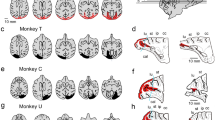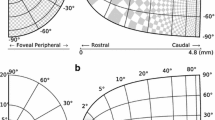Summary
The neurological basis of the maintenance of a stable visual scene by means of a corollary discharge mechanism was investigated. Monkeys were trained to detect and respond to sudden rapid movement of a small spot of light in an otherwise totally dark environment. There was no evidence that after removal of the frontal eye-fields, superior colliculi, or caudal superior temporal sulcus the animals confused real movement of the target with retinal image movement caused by changing the position of head and eyes. This result was confirmed by an examination of the ipsiversive turning that follows unilateral frontal eye-field or collicular ablation. If the turning is a compensation for apparent movement of the visual world when the eyes are moved it should not be present in total darkness. It was still present.
The thresholds for the smallest detectable instantaneous displacement of the target were also measured. The threshold was impaired by bilateral superior colliculus lesions but not by removal of the frontal eye-fields or cortex of the caudal part of the superior temporal sulcus.
Similar content being viewed by others
Abbreviations
- A:
-
nucleus anterior
- Br:
-
brachium of superior colliculus
- Caud:
-
caudate nucleus
- CC:
-
corpus callosum
- CG:
-
central grey
- CP:
-
cerebellar peduncles
- Cs1:
-
nucleus centralis lateralis superior
- F:
-
fornix
- IC:
-
inferior colliculus
- LD:
-
nucleus lateralis dorsalis
- LH:
-
lateral habenular nucleus
- mc, mf, pc:
-
pars multicellularis, multiformis and parvocellularis, respectively, of the dorsomedial nucleus
- MD:
-
nucleus medialis dorsalis
- Pcn:
-
nucleus paracentralis
- PT:
-
pretectal region
- Pul:
-
pulvinar
- SC:
-
superior colliculus
- TN:
-
trochlear nerve
- V:
-
nucleus ventralis
References
Akert K (1964) Comparative anatomy of the frontal cortex and thalamo-frontal connections. In: Warren J, Akert K (eds) The frontal granular cortex and behaviour. McGraw-Hill, New York, pp. 372–394
Anderson KV, Symmes D (1969) The superior colliculus and higher visual functions in the monkey. Brain Res 13: 37–52
Anderson ME, Yoshida M, Wilson VJ (1971) Influence of superior colliculus on cat neck motor neurons. J Neurophysiol 34: 898–907
Astruc J (1971) Corticofugal connections of Area 8 (frontal eye-field) in Macaca mulatta. Brain Res 33: 241–257
Benevento LA, Fallon JH (1975) The ascending projections of the superior colliculus in the rhesus monkey (Macaca mulatta). J Comp Neurol 160: 339–362
Bizzi E (1968) Discharge of frontal eye-field neurons during saccadic and following eye movements in unanaesthetised monkeys. Exp Brain Res 6: 69–80
Bizzi E, Schiller PH (1970) Single unit activity in the frontal eyefields of unanaesthetised monkeys during eye and head movements. Exp Brain Res 10: 151–158
Bos J, Benevento LA (1975) Projections of medial pulvinar to orbital frontal cortex and frontal eye-fields in the rhesus monkey. Exp Neurol 49: 487–496
Brucher JM (1966) The frontal eye-field of the monkey. Int J Neurol 5: 262–281
Bushnell MC, Goldberg ME (1979) The monkey frontal eye-fields have a neuronal signal that precedes visually guided saccades. Abstr Soc Neurosci 5: 779
Crosby EC, Yoss RE, Henderson JM (1952) The mammalian midbrain and isthmus regions. Part II: The fibre connections. D. The pattern for eye movements on the frontal eye-field and the discharge of specific portions of this field to and through midbrain levels. J Comp Neurol 97: 357–383
Cynader M, Berman N (1972) Receptive field organisation of monkey superior colliculus. J Neurophysiol 35: 187–201
Denny-Brown D (1962) The midbrain and motor integration. Proc R Soc Med 55: 527–538
Dubner R, Zeki SM (1971) Response properties and receptive fields of cells in an anatomically defined region of the superior temporal sulcus in the monkey. Brain Res 35: 528–532
Helmholtz H von (1910) Treatise on physiological optics. Dover, New York
Jampel RS (1960) Convergence, divergence, pupillary reactions, and accommodation of the eyes from faradic stimulation of the macaque brain. J Comp Neurol 115: 371–400
Kennard MA, Ectors L (1938) Forced circling in monkeys following lesions of the frontal lobes. J Neurophysiol 1: 45–54
Latto R, Cowey A (1971) Visual field defects after frontal eye-field lesions in monkeys. Brain Res 30: 1–24
Latto R, Cowey A (1972) Frontal eye-field lesions in monkeys. In: Dichgans J, Bizzi E (eds) Cerebral control of eye movements and motion perception. Karger, Basel (Bibliotheca ophthalmologica, vol 82, pp 159–168)
Leichnetz GR, Spencer RF, Astruc J (1979) The prefrontal projection to the superior colliculus in the monkey. Abstr Soc Neurosci 5: 117
Lin CS, Wagor E, Kaas JH (1974) Projections from the pulvinar to the middle temporal visual area (MT) in the owl monkey, Aotus trivirgatus. Brain Res 76: 145–149
MacKay DM (1970) Elevation of visual threshold by displacement of retinal image. Nature 225: 90–92
Mohler CW Goldberg ME, Wurtz RH (1973) Visual receptive fields of frontal eye-field neurones. Brain Res 61: 385–389
Peterson BW, Anderson ME, Fillion M, Wilson VJ (1971) Responses of reticulospinal neurones to stimulation of the superior colliculus. Brain Res 33: 495–498
Robinson DA, Fuchs AE (1969) Eye movements evoked by stimulation of the frontal eye-fields. J Neurophysiol 32: 637–648
Robinson DL, Wurtz RH (1976) Use of an extraretinal signal by monkey superior colliculus neurons to distinguish real from self-induced stimulus movements. J Neurophysiol 39: 852–870
Schiller PH, Koerner F (1971) Discharge characteristics of single units in superior colliculus of the alert rhesus monkey. J Neurophysiol 34: 920–936
Spatz WB (1975) Thalamic and other subcortical projections to area MT (visual area of superior temporal sulcus) in the marmoset, Callithrix jacchus. Brain Res 99: 129–134
Spatz WB, Tigges J (1973) Studies on the visual area MT in primates. II. Projection fibres to subcortical structures. Brain Res 61: 374–378
Sperry RW (1950) Neural basis of the spontaneous optokinetic response produced by visual inversion. J Comp Physiol Psychol 43: 482–489
Sprague JM, Meikle TH (1965) The role of the superior colliculus in visually guided behaviour. Exp Neurol 11: 115–146
Trojanowski JQ, Jacobson S (1976) A real and laminar distribution of some pulvinar cortical efferents in rhesus monkeys. J Comp Neurol 169: 371–392
Ungerleider LG, Mishkin M (1979) The striate projection zone in the superior temporal sulcus of Macaca mulatta: location and topographic organization. J Comp Neurol 188: 347–366
Holst E von (1954) Relations between the central nervous system and the peripheral organs. Br J Animal Behav 2: 89–94
Wetherill GB, Levitt H (1965) Sequential estimation of points on a psychometric function. Br J Math Statist Psychol 50: 1–10
Zeki SM (1974) Cells responding to changing image size and disparity in the cortex of the rhesus monkey. J Physiol (Lond) 242: 827–841
Author information
Authors and Affiliations
Rights and permissions
About this article
Cite this article
Collin, N.G., Cowey, A. The effect of ablation of frontal eye-fields and superior colliculi on visual stability and movement discrimination in rhesus monkeys. Exp Brain Res 40, 251–260 (1980). https://doi.org/10.1007/BF00237789
Received:
Issue Date:
DOI: https://doi.org/10.1007/BF00237789




